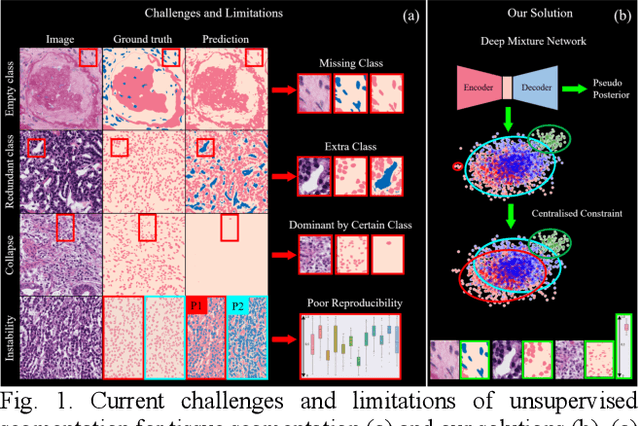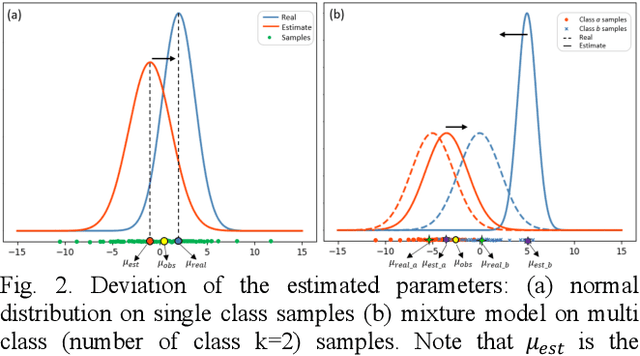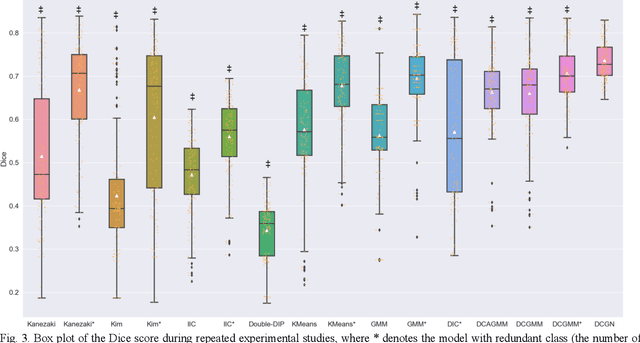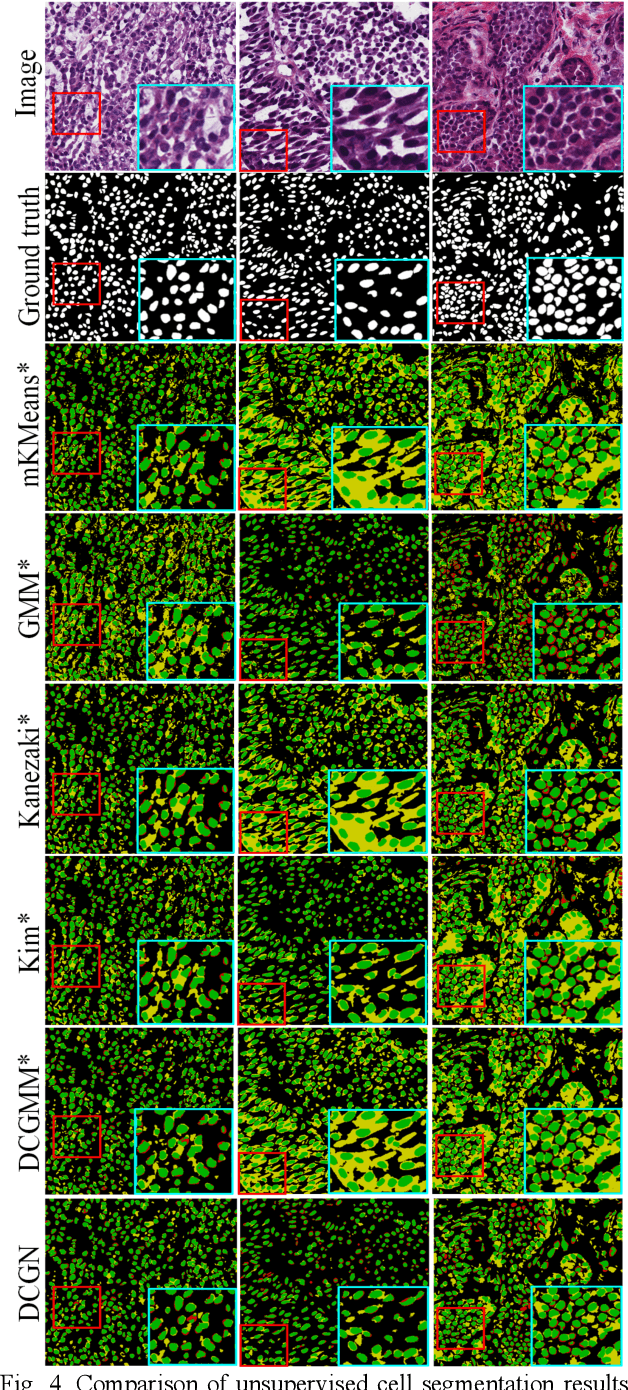Zhifan Gao
Revisiting Medical Image Retrieval via Knowledge Consolidation
Mar 12, 2025Abstract:As artificial intelligence and digital medicine increasingly permeate healthcare systems, robust governance frameworks are essential to ensure ethical, secure, and effective implementation. In this context, medical image retrieval becomes a critical component of clinical data management, playing a vital role in decision-making and safeguarding patient information. Existing methods usually learn hash functions using bottleneck features, which fail to produce representative hash codes from blended embeddings. Although contrastive hashing has shown superior performance, current approaches often treat image retrieval as a classification task, using category labels to create positive/negative pairs. Moreover, many methods fail to address the out-of-distribution (OOD) issue when models encounter external OOD queries or adversarial attacks. In this work, we propose a novel method to consolidate knowledge of hierarchical features and optimisation functions. We formulate the knowledge consolidation by introducing Depth-aware Representation Fusion (DaRF) and Structure-aware Contrastive Hashing (SCH). DaRF adaptively integrates shallow and deep representations into blended features, and SCH incorporates image fingerprints to enhance the adaptability of positive/negative pairings. These blended features further facilitate OOD detection and content-based recommendation, contributing to a secure AI-driven healthcare environment. Moreover, we present a content-guided ranking to improve the robustness and reproducibility of retrieval results. Our comprehensive assessments demonstrate that the proposed method could effectively recognise OOD samples and significantly outperform existing approaches in medical image retrieval (p<0.05). In particular, our method achieves a 5.6-38.9% improvement in mean Average Precision on the anatomical radiology dataset.
Task-oriented Uncertainty Collaborative Learning for Label-Efficient Brain Tumor Segmentation
Mar 07, 2025



Abstract:Multi-contrast magnetic resonance imaging (MRI) plays a vital role in brain tumor segmentation and diagnosis by leveraging complementary information from different contrasts. Each contrast highlights specific tumor characteristics, enabling a comprehensive understanding of tumor morphology, edema, and pathological heterogeneity. However, existing methods still face the challenges of multi-level specificity perception across different contrasts, especially with limited annotations. These challenges include data heterogeneity, granularity differences, and interference from redundant information. To address these limitations, we propose a Task-oriented Uncertainty Collaborative Learning (TUCL) framework for multi-contrast MRI segmentation. TUCL introduces a task-oriented prompt attention (TPA) module with intra-prompt and cross-prompt attention mechanisms to dynamically model feature interactions across contrasts and tasks. Additionally, a cyclic process is designed to map the predictions back to the prompt to ensure that the prompts are effectively utilized. In the decoding stage, the TUCL framework proposes a dual-path uncertainty refinement (DUR) strategy which ensures robust segmentation by refining predictions iteratively. Extensive experimental results on limited labeled data demonstrate that TUCL significantly improves segmentation accuracy (88.2\% in Dice and 10.853 mm in HD95). It shows that TUCL has the potential to extract multi-contrast information and reduce the reliance on extensive annotations. The code is available at: https://github.com/Zhenxuan-Zhang/TUCL_BrainSeg.
GEMA-Score: Granular Explainable Multi-Agent Score for Radiology Report Evaluation
Mar 07, 2025Abstract:Automatic medical report generation supports clinical diagnosis, reduces the workload of radiologists, and holds the promise of improving diagnosis consistency. However, existing evaluation metrics primarily assess the accuracy of key medical information coverage in generated reports compared to human-written reports, while overlooking crucial details such as the location and certainty of reported abnormalities. These limitations hinder the comprehensive assessment of the reliability of generated reports and pose risks in their selection for clinical use. Therefore, we propose a Granular Explainable Multi-Agent Score (GEMA-Score) in this paper, which conducts both objective quantification and subjective evaluation through a large language model-based multi-agent workflow. Our GEMA-Score parses structured reports and employs NER-F1 calculations through interactive exchanges of information among agents to assess disease diagnosis, location, severity, and uncertainty. Additionally, an LLM-based scoring agent evaluates completeness, readability, and clinical terminology while providing explanatory feedback. Extensive experiments validate that GEMA-Score achieves the highest correlation with human expert evaluations on a public dataset, demonstrating its effectiveness in clinical scoring (Kendall coefficient = 0.70 for Rexval dataset and Kendall coefficient = 0.54 for RadEvalX dataset). The anonymous project demo is available at: https://github.com/Zhenxuan-Zhang/GEMA_score.
Pretext Task Adversarial Learning for Unpaired Low-field to Ultra High-field MRI Synthesis
Mar 07, 2025Abstract:Given the scarcity and cost of high-field MRI, the synthesis of high-field MRI from low-field MRI holds significant potential when there is limited data for training downstream tasks (e.g. segmentation). Low-field MRI often suffers from a reduced signal-to-noise ratio (SNR) and spatial resolution compared to high-field MRI. However, synthesizing high-field MRI data presents challenges. These involve aligning image features across domains while preserving anatomical accuracy and enhancing fine details. To address these challenges, we propose a Pretext Task Adversarial (PTA) learning framework for high-field MRI synthesis from low-field MRI data. The framework comprises three processes: (1) The slice-wise gap perception (SGP) network aligns the slice inconsistencies of low-field and high-field datasets based on contrastive learning. (2) The local structure correction (LSC) network extracts local structures by restoring the locally rotated and masked images. (3) The pretext task-guided adversarial training process introduces additional supervision and incorporates a discriminator to improve image realism. Extensive experiments on low-field to ultra high-field task demonstrate the effectiveness of our method, achieving state-of-the-art performance (16.892 in FID, 1.933 in IS, and 0.324 in MS-SSIM). This enables the generation of high-quality high-field-like MRI data from low-field MRI data to augment training datasets for downstream tasks. The code is available at: https://github.com/Zhenxuan-Zhang/PTA4Unpaired_HF_MRI_SYN.
FedBM: Stealing Knowledge from Pre-trained Language Models for Heterogeneous Federated Learning
Feb 24, 2025Abstract:Federated learning (FL) has shown great potential in medical image computing since it provides a decentralized learning paradigm that allows multiple clients to train a model collaboratively without privacy leakage. However, current studies have shown that data heterogeneity incurs local learning bias in classifiers and feature extractors of client models during local training, leading to the performance degradation of a federation system. To address these issues, we propose a novel framework called Federated Bias eliMinating (FedBM) to get rid of local learning bias in heterogeneous federated learning (FL), which mainly consists of two modules, i.e., Linguistic Knowledge-based Classifier Construction (LKCC) and Concept-guided Global Distribution Estimation (CGDE). Specifically, LKCC exploits class concepts, prompts and pre-trained language models (PLMs) to obtain concept embeddings. These embeddings are used to estimate the latent concept distribution of each class in the linguistic space. Based on the theoretical derivation, we can rely on these distributions to pre-construct a high-quality classifier for clients to achieve classification optimization, which is frozen to avoid classifier bias during local training. CGDE samples probabilistic concept embeddings from the latent concept distributions to learn a conditional generator to capture the input space of the global model. Three regularization terms are introduced to improve the quality and utility of the generator. The generator is shared by all clients and produces pseudo data to calibrate updates of local feature extractors. Extensive comparison experiments and ablation studies on public datasets demonstrate the superior performance of FedBM over state-of-the-arts and confirm the effectiveness of each module, respectively. The code is available at https://github.com/CUHK-AIM-Group/FedBM.
Fuzzy Attention-based Border Rendering Network for Lung Organ Segmentation
Jun 23, 2024



Abstract:Automatic lung organ segmentation on CT images is crucial for lung disease diagnosis. However, the unlimited voxel values and class imbalance of lung organs can lead to false-negative/positive and leakage issues in advanced methods. Additionally, some slender lung organs are easily lost during the recycled down/up-sample procedure, e.g., bronchioles & arterioles, causing severe discontinuity issue. Inspired by these, this paper introduces an effective lung organ segmentation method called Fuzzy Attention-based Border Rendering (FABR) network. Since fuzzy logic can handle the uncertainty in feature extraction, hence the fusion of deep networks and fuzzy sets should be a viable solution for better performance. Meanwhile, unlike prior top-tier methods that operate on all regular dense points, our FABR depicts lung organ regions as cube-trees, focusing only on recycle-sampled border vulnerable points, rendering the severely discontinuous, false-negative/positive organ regions with a novel Global-Local Cube-tree Fusion (GLCF) module. All experimental results, on four challenging datasets of airway & artery, demonstrate that our method can achieve the favorable performance significantly.
DeepUniUSTransformer: Towards A Universal UltraSound Model with Prompted Guidance
Jun 03, 2024Abstract:Ultrasound is a widely used imaging modality in clinical practice due to its low cost, portability, and safety. Current research in general AI for healthcare focuses on large language models and general segmentation models, with insufficient attention to solutions addressing both disease prediction and tissue segmentation. In this study, we propose a novel universal framework for ultrasound, namely DeepUniUSTransformer, which is a promptable model accommodating multiple clinical task. The universality of this model is derived from its versatility across various aspects. It proficiently manages any ultrasound nature, any anatomical position, any input type and excelling not only in segmentation tasks but also in computer-aided diagnosis tasks. We introduce a novel module that incorporates this information as a prompt and seamlessly embedding it within the model's learning process. To train and validate our proposed model, we curated a comprehensive ultrasound dataset from publicly accessible sources, encompassing up to 7 distinct anatomical positions with over 9.7K annotations. Experimental results demonstrate that our model surpasses both a model trained on a single dataset and an ablated version of the network lacking prompt guidance. We will continuously expand the dataset and optimize the task specific prompting mechanism towards the universality in medical ultrasound. Model weights, datasets, and code will be open source to the public.
Data and Physics driven Deep Learning Models for Fast MRI Reconstruction: Fundamentals and Methodologies
Jan 29, 2024



Abstract:Magnetic Resonance Imaging (MRI) is a pivotal clinical diagnostic tool, yet its extended scanning times often compromise patient comfort and image quality, especially in volumetric, temporal and quantitative scans. This review elucidates recent advances in MRI acceleration via data and physics-driven models, leveraging techniques from algorithm unrolling models, enhancement-based models, and plug-and-play models to emergent full spectrum of generative models. We also explore the synergistic integration of data models with physics-based insights, encompassing the advancements in multi-coil hardware accelerations like parallel imaging and simultaneous multi-slice imaging, and the optimization of sampling patterns. We then focus on domain-specific challenges and opportunities, including image redundancy exploitation, image integrity, evaluation metrics, data heterogeneity, and model generalization. This work also discusses potential solutions and future research directions, emphasizing the role of data harmonization, and federated learning for further improving the general applicability and performance of these methods in MRI reconstruction.
Unsupervised Tissue Segmentation via Deep Constrained Gaussian Network
Aug 04, 2022



Abstract:Tissue segmentation is the mainstay of pathological examination, whereas the manual delineation is unduly burdensome. To assist this time-consuming and subjective manual step, researchers have devised methods to automatically segment structures in pathological images. Recently, automated machine and deep learning based methods dominate tissue segmentation research studies. However, most machine and deep learning based approaches are supervised and developed using a large number of training samples, in which the pixelwise annotations are expensive and sometimes can be impossible to obtain. This paper introduces a novel unsupervised learning paradigm by integrating an end-to-end deep mixture model with a constrained indicator to acquire accurate semantic tissue segmentation. This constraint aims to centralise the components of deep mixture models during the calculation of the optimisation function. In so doing, the redundant or empty class issues, which are common in current unsupervised learning methods, can be greatly reduced. By validation on both public and in-house datasets, the proposed deep constrained Gaussian network achieves significantly (Wilcoxon signed-rank test) better performance (with the average Dice scores of 0.737 and 0.735, respectively) on tissue segmentation with improved stability and robustness, compared to other existing unsupervised segmentation approaches. Furthermore, the proposed method presents a similar performance (p-value > 0.05) compared to the fully supervised U-Net.
Swin Deformable Attention U-Net Transformer (SDAUT) for Explainable Fast MRI
Jul 05, 2022



Abstract:Fast MRI aims to reconstruct a high fidelity image from partially observed measurements. Exuberant development in fast MRI using deep learning has been witnessed recently. Meanwhile, novel deep learning paradigms, e.g., Transformer based models, are fast-growing in natural language processing and promptly developed for computer vision and medical image analysis due to their prominent performance. Nevertheless, due to the complexity of the Transformer, the application of fast MRI may not be straightforward. The main obstacle is the computational cost of the self-attention layer, which is the core part of the Transformer, can be expensive for high resolution MRI inputs. In this study, we propose a new Transformer architecture for solving fast MRI that coupled Shifted Windows Transformer with U-Net to reduce the network complexity. We incorporate deformable attention to construe the explainability of our reconstruction model. We empirically demonstrate that our method achieves consistently superior performance on the fast MRI task. Besides, compared to state-of-the-art Transformer models, our method has fewer network parameters while revealing explainability. The code is publicly available at https://github.com/ayanglab/SDAUT.
 Add to Chrome
Add to Chrome Add to Firefox
Add to Firefox Add to Edge
Add to Edge